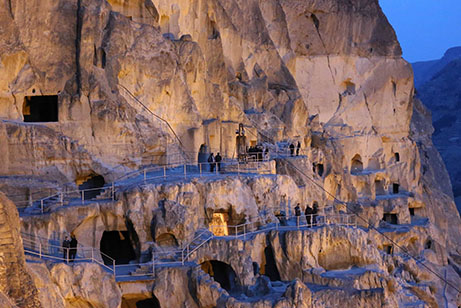Unique cave city offers tourists night tours

Georgia’s unique Vardzia cave city can now host visitors at night thanks to a new lighting system installed as part of the area’s renovation.
Major rehabilitation work is currently being carried out at the 12th century cave city in southern Georgia to restore the ancient site and prevent it from further damage. Georgia’s Prime Minister Irakli Garibashvili visited the site last night and learned about the ongoing restoration work.
"We have started the Vardzia rehabilitation project [and] it will continue for three to four years. Currently, we are making a detailed analysis [of the monument]. Every millimeter is being observed and really serious works are ongoing,” Garibashvili said.
"Vardzia has not been lit for decades. With our initiative we have illuminated Vardzia in order to make it an attractive place for tourists. For the past two years the number of tourists has increased [and] now it is necessary to present the uniqueness of the monument,” he noted.
Vardzia is a cave monastery complex that dated back to the 12th-13th Centuries. It is located in the valley of the Kura River, situated about 70km south of Borjomi. Experts said this was an outstanding monument showcasing medieval Georgian architecture.
Rehabilitation work started at the historic site about four months ago. Already, the Government has spent more than half a million GEL on the restoration project.
After inspecting the site, Garibashvili said the Vardzia rehabilitation works were being carried out in several directions. This involved installing a network of emergency and meteorological stations, diagnosing the rock through seismic-topographical and geophysical research and creating a 3D model of the site with complete and detailed information of the monument.
Emergency restoration and construction of water drain pipes was also taking place and by the end of 2015, research-diagnostic documentation of Vardzia’s wall art would be ready, the PM noted.
In addition, special stairs, hand rails and lights were being installed in some of the cave’s more remote and dangerous areas to make the area safer for visitors.
The country’s scientific and international institutes have united to work on the project, which is being led by UNESCO expert Dr. Claudio Margotini, who has a PhD in cultural heritage of engineering and geological sciences. He is also the Vice President of the landslide international consortium.
At the cave complex, hundreds of rooms and passages connecting the caves were built inside the mountainside, which stretched 800m, up to 50m deep and eight storeys high. Among the rooms were refectories, cells, storage areas and wine cellars.
 Tweet
Tweet  Share
Share